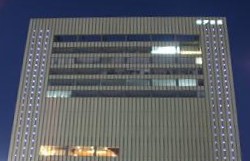 Japanese scientists researching the prospects of long-term human settlements on Mars are dreaming up ways to address the challenges of Martian agriculture. At a recent meeting of the Japan Geoscience Union held in Chiba, Professor Masamichi Yamashita (58) of the Japan Aeropsace Exploration Agency (JAXA) unveiled a unique space agriculture concept that would liven up the rather mundane task of cultivating rice in greenhouse domes. In his concept, settlers would plant mulberry trees and breed silkworms, the pupae of which would be consumed as a source of animal protein.
Japanese scientists researching the prospects of long-term human settlements on Mars are dreaming up ways to address the challenges of Martian agriculture. At a recent meeting of the Japan Geoscience Union held in Chiba, Professor Masamichi Yamashita (58) of the Japan Aeropsace Exploration Agency (JAXA) unveiled a unique space agriculture concept that would liven up the rather mundane task of cultivating rice in greenhouse domes. In his concept, settlers would plant mulberry trees and breed silkworms, the pupae of which would be consumed as a source of animal protein.
"Japan has the unique advantage of calling into play its excellent silk cultivation technology and long-established culinary culture," says Yamashita, who has been studying the subject since January 2005. As part of his research, Professor Yamashita has met with about 70 experts in fields ranging from medicine to agriculture to food science. "Space agriculture research is about the pursuit of near-complete recycling inside domes, something that can also be applied to safe organic agriculture on Earth," he says.
With trips to Mars taking 18 months each way, settlers will not be able to rely on frequent supply shipments from Earth. A self-sufficient supply of oxygen and food will be essential to the succes of any lengthy stay on Mars. The thin Martian atmosphere and a sunlight intensity half that on Earth pose additional agricultural challenges, and the unwillingness to taint the search for extraterrestrial life with microorganism-laden human and animal waste demands a rigorous recycling program.
Yamashita's concept involves the construction of transparent resin domes where rice, beans, potatoes, and mulberries are grown in soil consisting of a mixture of Martian sand and compost material. The plants would generate oxygen inside the domes, and the mulberry leaves would serve as food for the silkworms. The settlers could then either eat the silkworm pupae directly or use them as food for fish and poultry they raise.
"When cooked, silkworm pupae taste like shrimp or crab meat," says Professor Yamashita. "People all over Japan ate them during the food shortages after World War II, and you can still buy canned pupae in Nagano prefecture."
[Source: Nishinippon Shimbun]
 A spacewear fashion show featuring clothing designed for travel in weightless conditions was held at the University of Tokyo's Hongo campus on November 2.
A spacewear fashion show featuring clothing designed for travel in weightless conditions was held at the University of Tokyo's Hongo campus on November 2. 

 Japanese scientists researching the prospects of long-term human settlements on Mars are dreaming up ways to address the challenges of Martian agriculture. At a recent meeting of the
Japanese scientists researching the prospects of long-term human settlements on Mars are dreaming up ways to address the challenges of Martian agriculture. At a recent meeting of the 